The Evershed effect, named after the British astronomer John Evershed, [1] is the radial flow of gas across the photospheric surface of the penumbra of sunspots from the inner border with the umbra towards the outer edge. [2]
The speed varies from around 1 km/s at the border between the umbra and the penumbra to a maximum of around double this in the middle of the penumbra and falls off to zero at the outer edge of the penumbra. Evershed first detected this phenomenon in January 1909, whilst working at the Kodaikanal Solar Observatory in India, [3] when he found that the spectral lines of sunspots showed doppler shift.
Afterwards, measurements of the spectral emission lines emitted in the ultraviolet wavelengths have shown a systematic red-shift. The Evershed effect is common to every spectral line formed at a temperature below 105 K; this fact would imply a constant downflow from the transition region towards the chromosphere. The observed velocity is about 5 km/s. Of course, this is impossible, since if it were true, the corona would disappear in a short time instead of being suspended over the Sun at temperatures of million degrees over distances much larger than a solar radius.
Many theories have been proposed to explain this redshift in line profiles of the transition region, but the problem is still unsolved, since a coherent theory should take into account all the physical observations: UV line profiles are redshifted on average, but they show back and forth velocity oscillations at the same time.
In synthesis, the proposed mechanisms are:
The effect was commemorated in a postage stamp issued in India on 2 December 2008. [10]

A corona is the outermost layer of a star's atmosphere. It consists of plasma.

Sunspots are phenomena on the Sun's photosphere that appear as temporary spots that are darker than the surrounding areas. They are regions of reduced surface temperature caused by concentrations of magnetic flux that inhibit convection. Sunspots appear within active regions, usually in pairs of opposite magnetic polarity. Their number varies according to the approximately 11-year solar cycle.
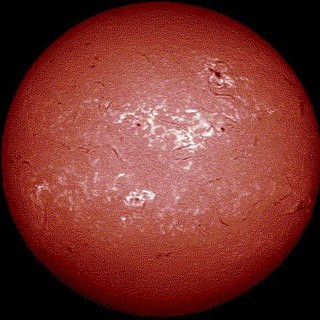
A chromosphere is a layer of a star's atmosphere. Most often it refers to the Sun, but not exclusively.

Seyfert galaxies are one of the two largest groups of active galaxies, along with quasars. They have quasar-like nuclei with very high surface brightnesses whose spectra reveal strong, high-ionisation emission lines, but unlike quasars, their host galaxies are clearly detectable.

In astronomical spectroscopy, the Lyman-alpha forest is a series of absorption lines in the spectra of distant galaxies and quasars arising from the Lyman-alpha electron transition of the neutral hydrogen atom. As the light travels through multiple gas clouds with different redshifts, multiple absorption lines are formed.
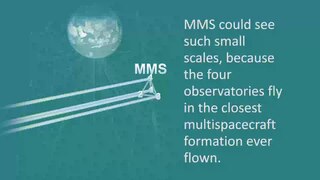
In plasma physics, an Alfvén wave, named after Hannes Alfvén, is a type of magnetohydrodynamic wave in which ions oscillate in response to a restoring force provided by an effective tension on the magnetic field lines.

In astronomy, metallicity is the abundance of elements present in an object that are heavier than hydrogen and helium. Most of the normal physical matter in the Universe is either hydrogen or helium, and astronomers use the word "metals" as a convenient short term for "all elements except hydrogen and helium". This word-use is distinct from the conventional chemical or physical definition of a metal as an electrically conducting solid. Stars and nebulae with relatively high abundances of heavier elements are called "metal-rich" in astrophysical terms, even though many of those elements are nonmetals in chemistry.

The emission spectrum of atomic hydrogen has been divided into a number of spectral series, with wavelengths given by the Rydberg formula. These observed spectral lines are due to the electron making transitions between two energy levels in an atom. The classification of the series by the Rydberg formula was important in the development of quantum mechanics. The spectral series are important in astronomical spectroscopy for detecting the presence of hydrogen and calculating red shifts.

In solar physics, a coronal loop is a well-defined arch-like structure in the Sun's atmosphere made up of relatively dense plasma confined and isolated from the surrounding medium by magnetic flux tubes. Coronal loops begin and end at two footpoints on the photosphere and project into the transition region and lower corona. They typically form and dissipate over periods of seconds to days and may span anywhere from 1 to 1,000 megametres in length.
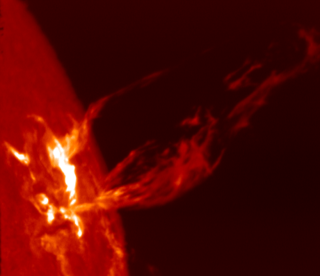
A stellar magnetic field is a magnetic field generated by the motion of conductive plasma inside a star. This motion is created through convection, which is a form of energy transport involving the physical movement of material. A localized magnetic field exerts a force on the plasma, effectively increasing the pressure without a comparable gain in density. As a result, the magnetized region rises relative to the remainder of the plasma, until it reaches the star's photosphere. This creates starspots on the surface, and the related phenomenon of coronal loops.
The Butcher–Oemler Effect is a scientific hypothesis suggesting the cores of galaxy clusters at intermediate redshift contain a larger fraction of blue galaxies than do the cores of low redshift clusters. The claim was first put forward by Harvey Butcher and Augustus Oemler in a 1978 Astrophysical Journal paper.

A Pea galaxy, also referred to as a Pea or Green Pea, might be a type of luminous blue compact galaxy that is undergoing very high rates of star formation. Pea galaxies are so-named because of their small size and greenish appearance in the images taken by the Sloan Digital Sky Survey (SDSS).

A nanoflare is a very small episodic heating event which happens in the corona, the external atmosphere of the Sun.
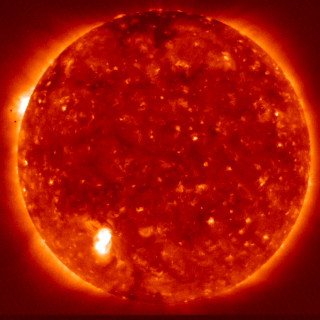
In astronomy and in astrophysics, for radiative losses of the solar corona, it is meant the energy flux radiated from the external atmosphere of the Sun, and, in particular, the processes of production of the radiation coming from the solar corona and transition region, where the plasma is optically-thin. On the contrary, in the chromosphere, where the temperature decreases from the photospheric value of 6000 K to the minimum of 4400 K, the optical depth is about 1, and the radiation is thermal.
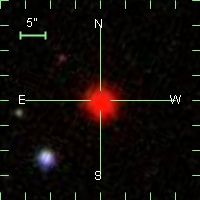
AZ Cancri (AZ Cnc) is a M-type flare star in the constellation Cancer. It has an apparent visual magnitude of approximately 17.59.

Magnesium monohydride is a molecular gas with formula MgH that exists at high temperatures, such as the atmospheres of the Sun and stars. It was originally known as magnesium hydride, although that name is now more commonly used when referring to the similar chemical magnesium dihydride.

Solar phenomena are the natural phenomena occurring within the outer atmosphere of the Sun. These phenomena take many forms, including solar wind, radio wave flux, solar flares, coronal mass ejections, coronal heating and sunspots.

Supra-arcade downflows (SADs) are sunward-traveling plasma voids that are sometimes observed in the Sun's outer atmosphere, or corona, during solar flares. In solar physics, arcade refers to a bundle of coronal loops, and the prefix supra indicates that the downflows appear above flare arcades. They were first described in 1999 using the Soft X-ray Telescope (SXT) on board the Yohkoh satellite. SADs are byproducts of the magnetic reconnection process that drives solar flares, but their precise cause remains unknown.

TON 618 is a hyperluminous, broad-absorption-line, radio-loud quasar and Lyman-alpha blob located near the border of the constellations Canes Venatici and Coma Berenices, with the projected comoving distance of approximately 18.2 billion light-years from Earth. It possesses one of the most massive black holes ever found, at 66 billion M☉.
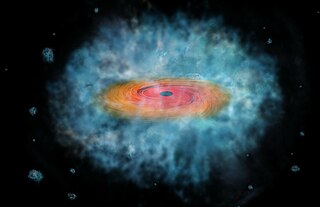
Direct collapse black holes are high-mass black hole seeds, putatively formed within the redshift range , when the Universe was about 100-250 million years old. Unlike seeds formed from the first population of stars (also known as Population III stars), direct collapse black hole seeds are formed by a direct, general relativistic instability. They are very massive, with a typical mass at formation of ~105 M☉. This category of black hole seeds was originally proposed theoretically to alleviate the challenge in building supermassive black holes already at redshift , as numerous observations to date have confirmed.